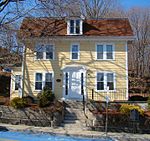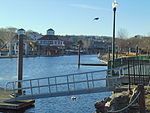Norwich City Hall (Connecticut)
Buildings and structures in Norwich, ConnecticutCity and town halls on the National Register of Historic Places in ConnecticutGovernment buildings completed in 1870Historic district contributing properties in ConnecticutNRHP infobox with nocat ... and 3 more
National Register of Historic Places in New London County, ConnecticutSecond Empire architecture in ConnecticutTown halls in Connecticut

Norwich City Hall is the seat of municipal government in Norwich, Connecticut. It is located at Union Street and Broadway, prominently overlooking the city's central business district. Built in 1870-73, when Norwich was still a town, it has served as the seat of municipal government since then. Architecturally it is a prominent statewide example of civic Second Empire architecture, and was listed on the National Register of Historic Places in 1983 (as Norwich Town Hall) for its architecture and history.
Excerpt from the Wikipedia article Norwich City Hall (Connecticut) (License: CC BY-SA 3.0, Authors, Images).Norwich City Hall (Connecticut)
Broadway, Norwich
Geographical coordinates (GPS) Address Phone number Website External links Nearby Places Show on map
Geographical coordinates (GPS)
| Latitude | Longitude |
|---|---|
| N 41.526111111111 ° | E -72.076111111111 ° |
Address
Norwich City Hall (Norwich Town Hall)
Broadway 100
06360 Norwich
Connecticut, United States
Open on Google Maps











